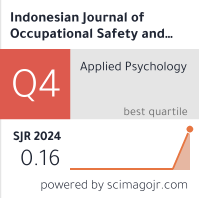Qualitative Dermal Exposure Assessment of Laboratory Technicians in Selected Chemical Laboratories in Eastern Province, Saudi Arabia
Downloads
Introduction: The assessment of dermal exposure is a complex task. The most commonly used methods have fundamental problems, and there are large gaps in the documentation and validation of the known assessment methods. This study aimed to determine the prevalence of self-reported skin problems in laboratory technicians. Additionally, to determine if there is an association between self-reported skin problems and work tasks and other exposure-related parameters, we developed a simple qualitative questionnaire that may be used for conducting qualitative dermal exposure assessments. Methods: A well-structured survey questionnaire was developed and 45 laboratory technicians were interviewed while conducting qualitative dermal exposure assessments in three selected laboratories. The sampling technique was a qualitative survey conducted through interviews. The examined variables included skin problems, work characteristics, and chemicals used. Results: This study indicated that 18% of technicians reported having skin problems, most notably inexperienced technicians or technicians with more than 6 years of experience. Skin problems were also identified in technicians who worked between one and eight hours, performed manual operations, and handled solvents. The prevalence of skin problems has also been associated with changing gloves. However, no significant differences were observed between the examined parameters and skin problems (p > 0.05). Conclusion: The prevalence of self-reported skin problems (18%) among laboratory technicians was not high. The prevalence of dry skin was low (11%). A well-structured questionnaire can be used to conduct a qualitative dermal risk assessment. As this was a cross-sectional study with a small sample size, it was not possible to establish a causative effect between exposure to workplace hazards and dermal problems.
A'Court, C. et al. (2011) ‘Type and Accuracy of Sphygmomanometers in Primary Care: A Cross-Sectional Observational Study', British Journal of General Practice, 61(590), pp. 598–603.
Akkus, Y. and Pinar, G. (2016) ‘Evaluation of the Prevalence, Type, Severity, and Risk Factors of Urinary Incontinence and its Impact on Quality of Life among Women in Turkey', International Urogynecology Journal, 27(6), pp. 887–893.
Anderson, S. E. and Meade, B. J. (2014) ‘Potential Health Effects Associated with Dermal Exposure to Occupational Chemicals', Environmental Health Insights, 8(S1), pp. 51–62.
Anna, D. H. (2011) The Occupational Environment: Its Evaluation, Control and Management. 3rd edn. Fairfax: American Industrial Hygiene Association.
Auffarth, J. et al. (2003) ‘RISKOFDERM – Europas Beschäftigte Sollen Nicht Länger Ihre Haut Zu Markte Tragen', Gefahrstoffe-Reinhaltung der Luft, 63(10), pp. 399–405.
Baldi, I. et al. (2006) ‘Pesticide Contamination of Workers in Vineyards in France', Journal of Exposure Science & Environmental Epidemiology, 16(2), pp. 115–24.
Berau of Labor Statistics (2007) Workplace Injuries and Illnesses in 2006.
Callahan, A. et al. (2014) ‘Winter Season, Frequent Hand Washing, and Irritant Patch Test Reactions to Detergents are Associated with Hand Dermatitis in Healthcare Workers', Dermatitis: Contact, Atopic, Occupational, Drug, 24(4), pp. 170–175.
Callahan, M. A. et al. (1987) Methods for Assessing Exposure to Chemical Substances: Methods for Assessing Consumer Exposure to Chemical Substances. Volumel 7. Michigan: U.S. Environmental Protection Agency.
Cherrie, J. W., Semple, S. and Brouwer, D. (2004) ‘Gloves and Dermal Exposure to Chemicals: Proposals for Evaluating Workplace Effectiveness', Annals of Occupational Hygiene, 48(7), pp. 607–615.
Ebrahimi, M. et al. (2011) ‘Temporomandibular Disorders and Related Factors in a Group of Iranian Adolescents: A Cross-sectional Survey.', Journal of Dental Research, Dental Clinics, Dental Prospects, 5(4), pp. 123–127.
Fenske, R. A. (2000) ‘Dermal Exposure: A Decade of Real Progress', The Annals of Occupational Hygiene, 44(7), pp. 489–491.
Galea, K. et al. (2018) ‘Laboratory Validation and Field Assessment of Petroleum Laboratory Technicians' Dermal Exposure to Crude Oil Using a Wipe Sampling Method', Annals of Work Exposures & Health, 62(6), pp. 733–741.
Gfatter, R., Hackl, P. and Braun, F. (1997) ‘Effects of Soap and Detergents on Skin Surface pH, Stratum Corneum Hydration and Fat Content in Infants', Dermatology, 195(3), pp. 258–262.
Griffiths, K. M. and Christensen, H. (2000) ‘Information in Practice Depression: Cross Sectional Survey', British Medical Journal, 321, pp. 1511–1515.
Hebisch, R. and Auffarth, J. (2001) ‘Dermal Exposure: How to Get Information', Applied Occupational and Environmental Hygiene, 16(2), pp. 169–173.
Ignacio, J. S. and Bullock, W. H. (2006) A Strategy for Assessing and Managing Occupational Exposures. Edited by 3. Alexandria: American Industrial Hygiene Association.
Lebailly, P. et al. (2009) ‘Exposure to Pesticides in Open-Field Farming in France', Annals of Occupational Hygiene, 53(1), pp. 69–81.
Marquart, J. et al. (2003) ‘Determinants of Dermal Exposure Relevant for Exposure Modelling in Regulatory Risk Assessment', Annals of Occupational Hygiene, 47(8), pp. 599–607.
Moody, R. P., Nadeau, B. and Chu, I. (1994) ‘) In Vitro Dermal Absorption of Pesticides: VI. In Vivo and In Vitro Comparisons of the Organochlorine Insecticide DDT in Rat, Guinea Pig, Pig, Human, and Tissue-cultured Skin', Toxicology in Vitro, 8(6), pp. 1225–1232.
Packham, C. (2006) ‘Alleged Allergenicity of Latex Gloves', The Annals of Occupational Hygiene, 50(7), p. 749.
Schneider, T. et al. (2000) ‘Dermal Exposure Assessment', The Annals of Occupational Hygiene, 44(7), pp. 493–499.
Setia, M. S. (2016) ‘Methodology Series Module 3: Cross-sectional Studies', Indian Journal of Dermatology, 61(3), pp. 261–264.
Sithamparanadaraj, R. (2008) Controlling Skin Exposure to Chemicals and Wet-work - A Practical Book. Stourbridge: RMS Publishing.
Susanto A. et al. (2020) Chemical Health Risk Assessment (CHRA) in a Wet Assay and Fire Assay Laboratory (WAFAL),Acta Scientific Medical Sciences, 4(10), pp. 91–101
Tielemans, E. et al. (2010) ‘Exposure to Fungicides in Fruit Growing: Re-Entry Time as a Predictor for Dermal Exposure', American Industrial Hygiene Association Journal, 60(6), pp. 789–793.
Trommer, H. and Neubert, R. H. H. (2006) ‘Overcoming the Stratum Corneum: The Modulation of Skin Penetration', Skin Pharmacology and Physiology, 19(2), pp. 106–121.
Van-Wendel-De-Joode, B. et al. (2003) ‘DREAM: A Method for Semi-Quantitative Dermal Exposure Assessment', Annals of Occupational Hygiene, 47(1), pp. 71–87.
Visscher, M. O. and Wickett, R. R. (2012) ‘Hand Hygiene Compliance and Irritant Dermatitis: A Juxtaposition of Healthcare Issues', International Journal of Cosmetic Science, 34(5), pp. 402–415.
Voegeli, D. (2008) ‘The Effect of Washing and Drying Practices on Skin Barrier Function', Journal of Wound, Ostomy and Continence Nursing, 35(1), pp. 84–90.
Van Wendel De Joode, B. et al. (2005) ‘Accuracy of a Semiquantitative Method for Dermal Exposure Assessment (DREAM)', Occupational and Environmental Medicine, 62(9), pp. 623–632.
Williams, P. and Burson, J. (1985) Industrial Toxicology: Safety and Health Applications in the Workplace. New York: Van Nostrand Reinhold.

This work is licensed under a Creative Commons Attribution-NonCommercial-ShareAlike 4.0 International License.

In order to be accepted and published by The Indonesian Journal of Occupational Safety and Health, Author(s) who submit an article should complete all the review process. The copyright of received articles assigned to the The Indonesian Journal of Occupational Safety and Health and Department of Safety and Health, Universitas Airlangga as publishers of the journal. The intended copyright includes the rights to publish articles in various forms (including reprints).
The Editorial Team of The Indonesian Journal Of Occupational Safety and Health and Department of Safety and Health strive to ensure that no errors occur in the articles that have been published, both data errors and statements in the article.
Users of this website will be licensed to use materials from this website following the Creative Commons Attribution-NonCommercial-ShareAlike 4.0 International License. No fees charged. Please use the materials accordingly.
------------------------------------------------------------------------------------------------------------------------------------------------------------------------------------------
Attribution ” You must give appropriate credit, provide a link to the license, and indicate if changes were made. You may do so in any reasonable manner, but not in any way that suggests the licensor endorses you or your use.
NonCommercial ” You may not use the material for commercial purposes.
ShareAlike ” If you remix, transform, or build upon the material, you must distribute your contributions under the same license as the original.







 How to Submit Articles in OJS
How to Submit Articles in OJS

























